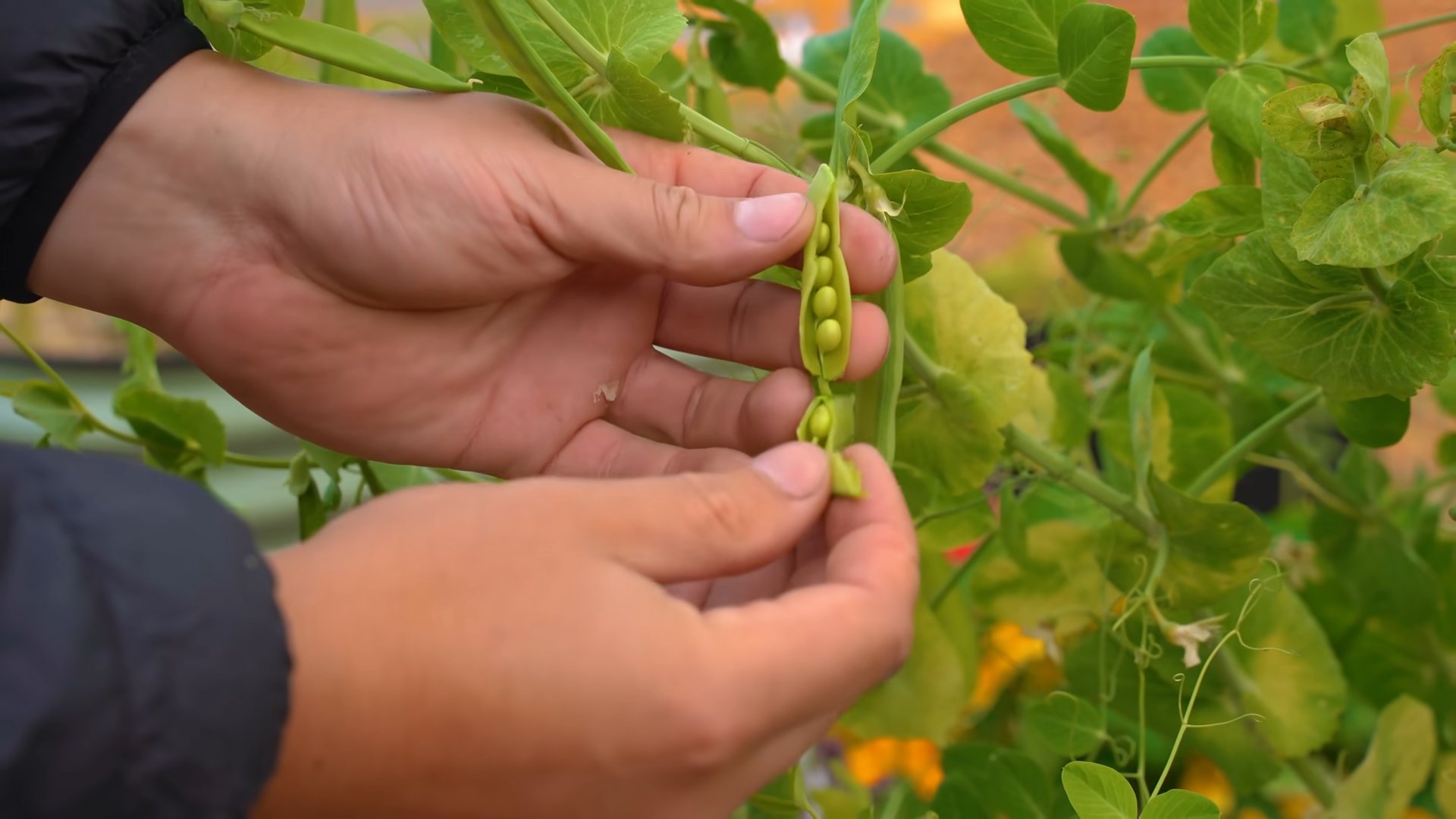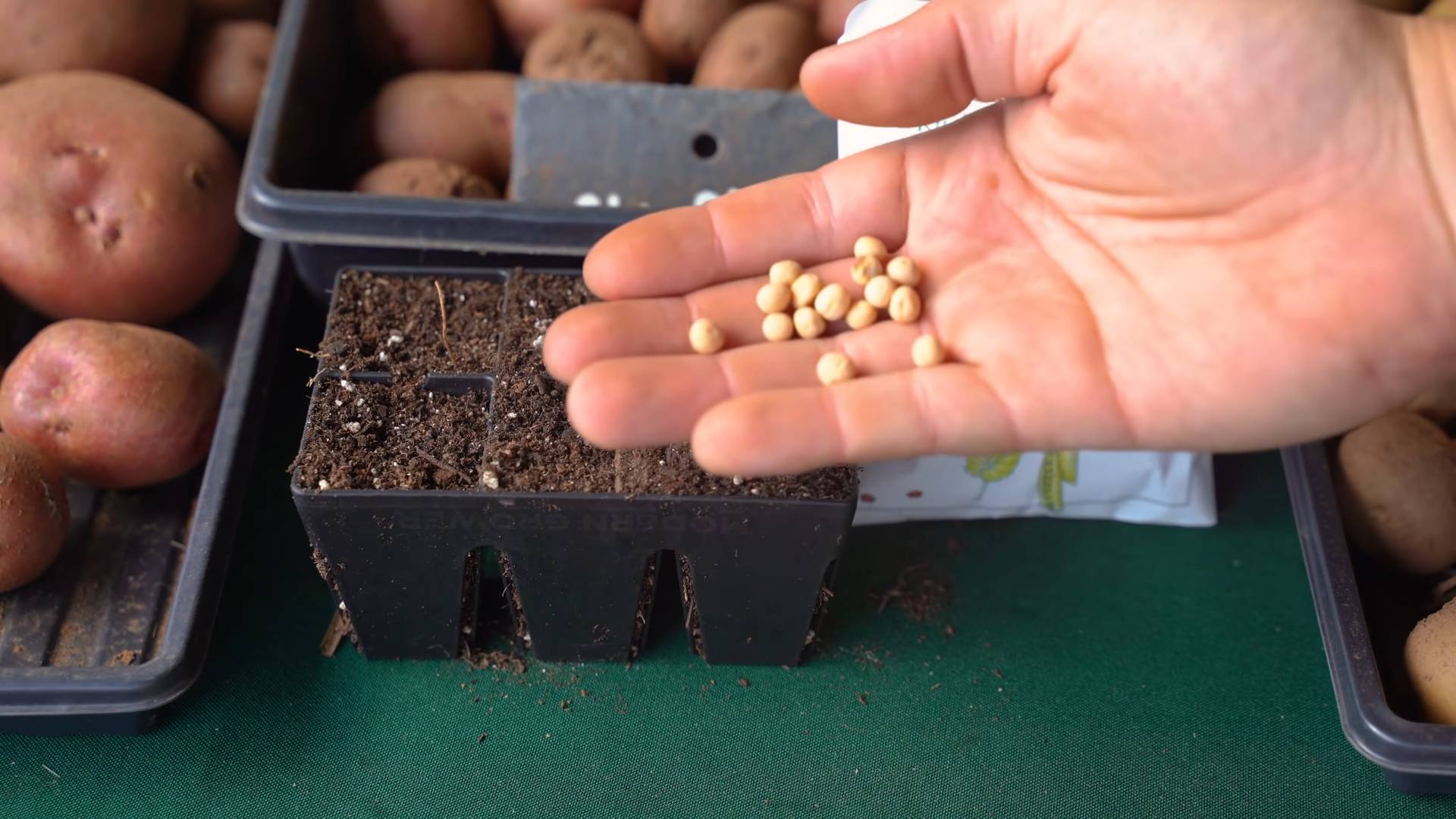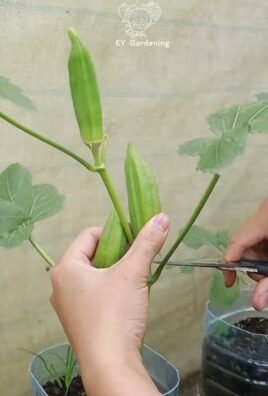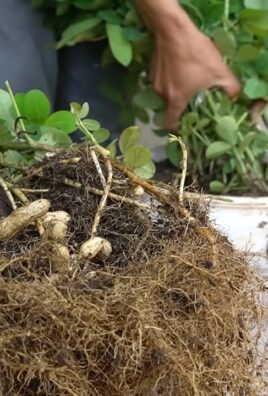Growing peas indoors might sound like a whimsical dream, especially if you’re picturing sprawling vines taking over your living room! But trust me, it’s a surprisingly achievable and rewarding project, even if you don’t have a sprawling garden. For centuries, people have cultivated food in limited spaces, from ancient rooftop gardens in bustling cities to windowsill herbs in cozy cottages. This resourceful spirit lives on, and now, with a few clever tricks, you can bring the joy of fresh, homegrown peas right into your home.
Why bother growing peas indoors, you ask? Well, imagine plucking sweet, crisp pea pods straight from the vine in the middle of winter! No more bland, store-bought peas – just the vibrant flavor of freshly grown goodness. Plus, it’s a fantastic way to beat the winter blues, connect with nature, and even teach kids about where their food comes from. This DIY guide will equip you with the knowledge and simple techniques to successfully cultivate these delightful legumes within the comfort of your own four walls. Get ready to unleash your inner gardener and enjoy the satisfaction of a bountiful indoor harvest!

Growing Peas Indoors: A Complete DIY Guide
Hey there, fellow gardening enthusiasts! Dreaming of fresh, sweet peas even when the weather outside is frightful? Well, you’re in luck! I’m going to walk you through everything you need to know to successfully grow peas indoors. It’s easier than you might think, and the reward of homegrown peas in the middle of winter is absolutely worth it. Let’s get started!
Choosing the Right Pea Variety
First things first, not all pea varieties are created equal when it comes to indoor growing. We need to pick varieties that are compact and don’t require a ton of space to vine out. Here are a few of my favorites:
* Dwarf Varieties: These are your best bet. Look for names like ‘Little Marvel,’ ‘Tom Thumb,’ or ‘Sugar Ann.’ They stay relatively small and are perfect for containers.
* Bush Varieties: Similar to dwarf varieties, bush peas are compact and don’t need trellising. ‘Sugar Snap’ bush types are a great option.
* Avoid Vining Varieties: While you *can* grow vining varieties indoors, they require significant support and space. Unless you have a dedicated indoor garden setup, I’d recommend sticking with the dwarf or bush types.
Gathering Your Supplies
Okay, now that we’ve chosen our pea variety, let’s gather our supplies. Here’s what you’ll need:
* Pea Seeds: Obviously! Make sure you get them from a reputable source.
* Containers: Choose containers that are at least 6 inches deep and wide. Peas need room for their roots to grow. I prefer using plastic pots with drainage holes.
* Potting Mix: Use a high-quality potting mix that drains well. Avoid using garden soil, as it can compact and not provide adequate drainage.
* Grow Lights: This is crucial for indoor growing. Peas need at least 6-8 hours of direct light per day. If you don’t have a sunny windowsill, invest in a good set of grow lights. LED grow lights are energy-efficient and work great.
* Watering Can or Spray Bottle: For watering your peas.
* Trellis or Support (Optional): If you’re growing a bush variety or a slightly taller dwarf variety, a small trellis or some stakes can help support the plants.
* Seed Starting Tray (Optional): You can start your seeds in a seed starting tray before transplanting them to larger containers. This isn’t necessary, but it can give you a head start.
Planting Your Pea Seeds
Alright, time to get our hands dirty! Here’s how to plant your pea seeds:
1. Soak the Seeds (Optional): Soaking your pea seeds in water for 12-24 hours before planting can help speed up germination. I usually do this, but it’s not absolutely essential.
2. Fill Your Containers: Fill your containers with potting mix, leaving about an inch of space at the top.
3. Sow the Seeds: Make small holes about 1 inch deep and 2 inches apart. Place 2-3 seeds in each hole. Planting multiple seeds ensures that at least one will germinate.
4. Cover the Seeds: Gently cover the seeds with potting mix.
5. Water Thoroughly: Water the soil thoroughly until it’s moist but not soggy.
6. Label Your Containers: Don’t forget to label your containers with the pea variety and the date you planted them.
Caring for Your Indoor Pea Plants
Now that your peas are planted, it’s time to provide them with the care they need to thrive.
1. Light: Place your containers under grow lights or in a sunny windowsill. Remember, peas need at least 6-8 hours of direct light per day. If you’re using grow lights, position them a few inches above the plants.
2. Watering: Keep the soil consistently moist but not soggy. Water when the top inch of soil feels dry to the touch. Avoid overwatering, as this can lead to root rot.
3. Temperature: Peas prefer cooler temperatures, ideally between 60-70°F (15-21°C). Avoid placing them near heat sources.
4. Fertilizing: Peas are relatively light feeders, but they can benefit from a light feeding of a balanced liquid fertilizer every 2-3 weeks. Follow the instructions on the fertilizer label. I like to use a fertilizer specifically formulated for vegetables.
5. Support (If Needed): If you’re growing a bush variety or a taller dwarf variety, provide support for the plants as they grow. You can use a small trellis, stakes, or even just some string tied to the container.
6. Air Circulation: Good air circulation is important to prevent fungal diseases. Make sure your plants have enough space between them and that there’s good airflow in the room. A small fan can help improve air circulation.
7. Pest Control: Keep an eye out for pests like aphids or spider mites. If you spot any pests, you can try spraying them with insecticidal soap or neem oil. I always prefer to start with the least toxic options first.
Pollination
Peas are self-pollinating, which means they don’t need bees or other insects to pollinate them. However, indoor plants may benefit from a little help. You can hand-pollinate your peas by gently shaking the plants or using a small brush to transfer pollen from one flower to another. This is especially helpful if you’re not seeing a lot of pod development.
Harvesting Your Peas
The best part! Harvesting your peas is the reward for all your hard work.
1. Timing: The time it takes for peas to mature depends on the variety, but generally, you can expect to start harvesting about 60-70 days after planting.
2. Harvesting: Harvest your peas when the pods are plump and filled with peas. The pods should be firm but not hard.
3. Picking: Gently pick the pods from the plant. Use scissors or pruning shears if necessary.
4. Enjoy: Enjoy your fresh, homegrown peas! You can eat them raw, steamed, or added to your favorite dishes.
Troubleshooting
Even with the best care, you might encounter some problems when growing peas indoors. Here are a few common issues and how to address them:
* Poor Germination: If your seeds aren’t germinating, make sure the soil is moist and the temperature is warm enough. You can also try scarifying the seeds by gently scratching the surface with sandpaper before planting.
* Yellowing Leaves: Yellowing leaves can be a sign of overwatering, underwatering, or nutrient deficiency. Check the soil moisture and adjust your watering accordingly. If the soil is consistently moist, you may be overwatering. If the soil is dry, you may be underwatering. You can also try fertilizing your plants with a balanced liquid fertilizer.
* Leggy Growth: Leggy growth (tall, spindly plants) is usually a sign of insufficient light. Make sure your plants are getting enough light, either from grow lights or a sunny windowsill.
* Lack of Pods: If you
Hey there, fellow gardening enthusiasts! Dreaming of fresh, sweet peas even when the weather outside is frightful? Well, you’re in luck! I’m going to walk you through everything you need to know to successfully grow peas indoors. It’s easier than you might think, and the reward of homegrown peas in the middle of winter is absolutely worth it. Let’s get started!
Choosing the Right Pea Variety
First things first, not all pea varieties are created equal when it comes to indoor growing. We need to pick varieties that are compact and don’t require a ton of space to vine out. Here are a few of my favorites:
* Dwarf Varieties: These are your best bet. Look for names like ‘Little Marvel,’ ‘Tom Thumb,’ or ‘Sugar Ann.’ They stay relatively small and are perfect for containers.
* Bush Varieties: Similar to dwarf varieties, bush peas are compact and don’t need trellising. ‘Sugar Snap’ bush types are a great option.
* Avoid Vining Varieties: While you *can* grow vining varieties indoors, they require significant support and space. Unless you have a dedicated indoor garden setup, I’d recommend sticking with the dwarf or bush types.
Gathering Your Supplies
Okay, now that we’ve chosen our pea variety, let’s gather our supplies. Here’s what you’ll need:
* Pea Seeds: Obviously! Make sure you get them from a reputable source.
* Containers: Choose containers that are at least 6 inches deep and wide. Peas need room for their roots to grow. I prefer using plastic pots with drainage holes.
* Potting Mix: Use a high-quality potting mix that drains well. Avoid using garden soil, as it can compact and not provide adequate drainage.
* Grow Lights: This is crucial for indoor growing. Peas need at least 6-8 hours of direct light per day. If you don’t have a sunny windowsill, invest in a good set of grow lights. LED grow lights are energy-efficient and work great.
* Watering Can or Spray Bottle: For watering your peas.
* Trellis or Support (Optional): If you’re growing a bush variety or a slightly taller dwarf variety, a small trellis or some stakes can help support the plants.
* Seed Starting Tray (Optional): You can start your seeds in a seed starting tray before transplanting them to larger containers. This isn’t necessary, but it can give you a head start.
Planting Your Pea Seeds
Alright, time to get our hands dirty! Here’s how to plant your pea seeds:
1. Soak the Seeds (Optional): Soaking your pea seeds in water for 12-24 hours before planting can help speed up germination. I usually do this, but it’s not absolutely essential.
2. Fill Your Containers: Fill your containers with potting mix, leaving about an inch of space at the top.
3. Sow the Seeds: Make small holes about 1 inch deep and 2 inches apart. Place 2-3 seeds in each hole. Planting multiple seeds ensures that at least one will germinate.
4. Cover the Seeds: Gently cover the seeds with potting mix.
5. Water Thoroughly: Water the soil thoroughly until it’s moist but not soggy.
6. Label Your Containers: Don’t forget to label your containers with the pea variety and the date you planted them.
Caring for Your Indoor Pea Plants
Now that your peas are planted, it’s time to provide them with the care they need to thrive.
1. Light: Place your containers under grow lights or in a sunny windowsill. Remember, peas need at least 6-8 hours of direct light per day. If you’re using grow lights, position them a few inches above the plants.
2. Watering: Keep the soil consistently moist but not soggy. Water when the top inch of soil feels dry to the touch. Avoid overwatering, as this can lead to root rot.
3. Temperature: Peas prefer cooler temperatures, ideally between 60-70°F (15-21°C). Avoid placing them near heat sources.
4. Fertilizing: Peas are relatively light feeders, but they can benefit from a light feeding of a balanced liquid fertilizer every 2-3 weeks. Follow the instructions on the fertilizer label. I like to use a fertilizer specifically formulated for vegetables.
5. Support (If Needed): If you’re growing a bush variety or a taller dwarf variety, provide support for the plants as they grow. You can use a small trellis, stakes, or even just some string tied to the container.
6. Air Circulation: Good air circulation is important to prevent fungal diseases. Make sure your plants have enough space between them and that there’s good airflow in the room. A small fan can help improve air circulation.
7. Pest Control: Keep an eye out for pests like aphids or spider mites. If you spot any pests, you can try spraying them with insecticidal soap or neem oil. I always prefer to start with the least toxic options first.
Pollination
Peas are self-pollinating, which means they don’t need bees or other insects to pollinate them. However, indoor plants may benefit from a little help. You can hand-pollinate your peas by gently shaking the plants or using a small brush to transfer pollen from one flower to another. This is especially helpful if you’re not seeing a lot of pod development.
Harvesting Your Peas
The best part! Harvesting your peas is the reward for all your hard work.
1. Timing: The time it takes for peas to mature depends on the variety, but generally, you can expect to start harvesting about 60-70 days after planting.
2. Harvesting: Harvest your peas when the pods are plump and filled with peas. The pods should be firm but not hard.
3. Picking: Gently pick the pods from the plant. Use scissors or pruning shears if necessary.
4. Enjoy: Enjoy your fresh, homegrown peas! You can eat them raw, steamed, or added to your favorite dishes.
Troubleshooting
Even with the best care, you might encounter some problems when growing peas indoors. Here are a few common issues and how to address them:
* Poor Germination: If your seeds aren’t germinating, make sure the soil is moist and the temperature is warm enough. You can also try scarifying the seeds by gently scratching the surface with sandpaper before planting.
* Yellowing Leaves: Yellowing leaves can be a sign of overwatering, underwatering, or nutrient deficiency. Check the soil moisture and adjust your watering accordingly. If the soil is consistently moist, you may be overwatering. If the soil is dry, you may be underwatering. You can also try fertilizing your plants with a balanced liquid fertilizer.
* Leggy Growth: Leggy growth (tall, spindly plants) is usually a sign of insufficient light. Make sure your plants are getting enough light, either from grow lights or a sunny windowsill.
* Lack of Pods: If your plants are flowering but not producing pods, it could be due to poor pollination or temperature stress. Try hand-pollinating your plants and make sure the temperature is within the ideal range.
* Pests: Keep an eye out for pests like aphids or spider mites. If you spot any pests, you can try spraying them with insecticidal soap or neem oil.
Extending Your Harvest
Want to keep the pea party going? You can extend your harvest by succession planting. This means planting new seeds every 2-3 weeks. This will ensure that you have a continuous supply of fresh peas.
Saving Seeds
If you’re growing heirloom pea varieties, you can save the seeds for next year. Allow some of the pods to dry completely on the plant. Once the pods are dry and brittle, you can shell them and store the seeds in an airtight container in a cool, dry place.
Final Thoughts
Growing peas indoors is a rewarding experience that allows you to enjoy fresh, homegrown peas even when the weather outside is less than ideal. With a little bit of care and attention, you can successfully grow peas indoors and enjoy a delicious harvest. So, grab your seeds, get your hands dirty, and start growing! Happy gardening!

Conclusion
So, there you have it! Growing peas indoors is not only possible, but it’s also a surprisingly rewarding experience. Forget relying solely on the unpredictable whims of outdoor weather and limited growing seasons. With this simple DIY trick, you can enjoy the sweet, tender taste of freshly harvested peas right from your own home, all year round.
Why is this a must-try? Because it puts you in control. You dictate the environment, ensuring optimal growing conditions for your pea plants. You bypass the common challenges of outdoor gardening, such as pests, diseases, and fluctuating temperatures. And, perhaps most importantly, you gain the immense satisfaction of nurturing life from seed to harvest, all within the cozy confines of your living space.
But the beauty of this method lies in its adaptability. Feel free to experiment with different pea varieties. Snow peas, snap peas, and shelling peas all thrive indoors, each offering a unique flavor and texture. Consider using different types of containers, from repurposed plastic tubs to stylish terracotta pots. Just ensure they have adequate drainage. You can also play around with different lighting setups. While a sunny windowsill works wonders, supplementing with grow lights can significantly boost your yield, especially during the darker winter months.
Don’t be afraid to get creative! Try companion planting. Herbs like mint or chamomile can deter pests and enhance the flavor of your peas. Or, consider adding a small trellis or support structure to your container to encourage vertical growth and maximize space.
This DIY method for growing peas indoors is more than just a gardening project; it’s an opportunity to connect with nature, cultivate patience, and enjoy the fruits (or rather, vegetables) of your labor. It’s a chance to bring a touch of green into your home and savor the unparalleled taste of homegrown produce.
We wholeheartedly encourage you to give this a try. It’s easier than you might think, and the results are well worth the effort. Once you’ve experienced the joy of harvesting your own indoor peas, you’ll wonder why you didn’t start sooner.
And most importantly, we want to hear about your experience! Share your tips, tricks, and triumphs in the comments below. Let us know what worked for you, what challenges you faced, and what delicious dishes you created with your homegrown peas. Your feedback will not only inspire others but also help us refine and improve this guide for future indoor gardeners. So, grab your seeds, gather your supplies, and get ready to embark on a pea-growing adventure! Happy gardening!
Frequently Asked Questions (FAQ)
What are the best pea varieties to grow indoors?
While most pea varieties can be grown indoors, some tend to perform better than others. Bush varieties, such as ‘Little Marvel’ or ‘Sugar Ann,’ are generally preferred because they are more compact and don’t require as much vertical space as vining varieties. However, if you have ample space and a sturdy trellis, you can certainly grow vining varieties like ‘Sugar Snap’ or ‘Oregon Sugar Pod.’ Experiment to see what works best for your setup and preferences. Remember to check the seed packet for specific information on the plant’s growth habit and space requirements.
How much light do indoor pea plants need?
Peas need a significant amount of light to thrive. Ideally, they should receive at least 6-8 hours of direct sunlight per day. A south-facing windowsill is often the best location. However, if you don’t have access to sufficient natural light, you can supplement with grow lights. Fluorescent or LED grow lights are excellent options. Position the lights a few inches above the plants and keep them on for 12-16 hours per day. Monitor your plants closely and adjust the lighting as needed. Leggy growth (long, spindly stems) is a sign that your plants aren’t getting enough light.
What type of soil should I use for growing peas indoors?
Use a well-draining potting mix that is rich in organic matter. Avoid using garden soil, as it can be too heavy and may contain pests or diseases. A good potting mix will provide the necessary nutrients and drainage for healthy pea growth. You can also amend your potting mix with compost or other organic materials to further improve its fertility.
How often should I water my indoor pea plants?
Water your pea plants regularly, keeping the soil consistently moist but not waterlogged. Overwatering can lead to root rot, so it’s important to allow the top inch of soil to dry out slightly between waterings. The frequency of watering will depend on factors such as the size of your container, the temperature, and the humidity. Check the soil moisture regularly and adjust your watering schedule accordingly.
Do I need to fertilize my indoor pea plants?
Peas are relatively light feeders, but they will benefit from occasional fertilization. Use a balanced liquid fertilizer diluted to half strength every 2-3 weeks. Avoid over-fertilizing, as this can lead to excessive foliage growth at the expense of pod production. You can also amend your soil with compost or other organic materials to provide a slow-release source of nutrients.
How long does it take for peas to mature indoors?
The time it takes for peas to mature indoors will vary depending on the variety and growing conditions. Generally, you can expect to harvest your first peas about 60-70 days after planting. Check the seed packet for specific information on the maturity time of your chosen variety.
How do I know when my peas are ready to harvest?
The best time to harvest peas is when the pods are plump and filled with peas, but before they become too tough or starchy. The pods should be bright green and firm to the touch. For snap peas, harvest when the pods are fully developed but still tender. For snow peas, harvest when the pods are flat and the peas are just beginning to develop.
What are some common problems when growing peas indoors?
Some common problems when growing peas indoors include aphids, powdery mildew, and root rot. Aphids can be controlled with insecticidal soap or neem oil. Powdery mildew can be prevented by providing good air circulation and avoiding overhead watering. Root rot can be prevented by using well-draining soil and avoiding overwatering. Regularly inspect your plants for signs of pests or diseases and take action promptly to prevent them from spreading.
Can I grow peas indoors year-round?
Yes, you can grow peas indoors year-round, provided you have adequate light and temperature control. With proper care and attention, you can enjoy a continuous supply of fresh, homegrown peas, regardless of the season.
How do I support my pea plants indoors?
Vining pea varieties need support to climb. You can use a small trellis, stakes, or even string to provide support. Bush varieties may not need support, but they can benefit from it, especially as they become laden with pods. Make sure the support structure is sturdy enough to hold the weight of the plants.




Leave a Comment